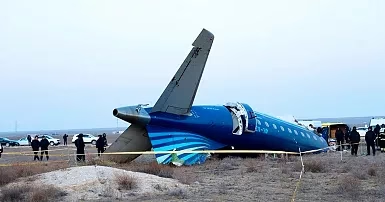An Azerbaijan Airlines flight that crashed on Christmas Day near Aktau, Kazakhstan, is believed to have been struck by a Russian surface-to-air missile, according to sources within the Azerbaijani government.
The crash, which killed at least 38 people, including the two pilots, has raised suspicions of Russian involvement in the incident.

Flight J28243, an Embraer 190, was en route from Baku, Azerbaijan, to Grozny, Russia, when it tragically crashed two miles south of Aktau Airport.
The jet reportedly burst into flames upon impact, leaving a scene of devastation and raising concerns that it may have been shot down. Some speculated the missile strike occurred after the aircraft diverted from an area recently defended by Russia against Ukrainian drone attacks.
A preliminary investigation by Azerbaijani authorities suggests the plane was hit during a flyover near Grozny, with a missile exploding beside it.
Shrapnel from the blast is believed to have caused significant damage to the aircraft, killing many of the 62 passengers and crew.

Eyewitness accounts from passengers and crew suggest they heard an explosion before the plane descended into the fireball that followed its crash landing.
Russian President Vladimir Putin’s spokesperson, Dmitry Peskov, warned against premature conclusions, stating, “It would be incorrect to make any hypotheses before the investigation comes to conclusions.” He further urged the public to await the official results of the inquiry.
The incident began when the aircraft, initially scheduled to land at Grozny, was diverted to Makhachkala before rerouting to Aktau across the Caspian Sea.
Though foggy weather was initially cited as a contributing factor, passengers aboard the flight reported hearing a loud explosion just before the crash. Some survivors claimed to have witnessed bullet-like holes in the fuselage, adding to suspicions of external firepower.

Andriy Kovalenko, head of the Ukrainian National Security and Defense Council’s Center for Countering Disinformation, remarked on Telegram that Russia had failed to close airspace over Grozny, allowing the incident to unfold.
He also suggested that the damage sustained by the aircraft may have been caused by Russian military action, forcing the plane to divert and ultimately crash in Kazakhstan.

Kazakhstan’s Senate Chairman Ashimbayev Maulen, speaking shortly after the crash, confirmed that the cause of the disaster remains under investigation. “None of these countries—Azerbaijan, Russia, or Kazakhstan—is interested in hiding information. All information will be made available to the public,” Maulen assured.
Footage captured by passenger Subkhon Rakhimov, who survived the crash with only minor injuries, showed the flight’s final moments.
The video revealed frantic scenes inside the cabin, with passengers praying and preparing for impact. Rakhimov praised the flight crew for their professionalism during the emergency despite uncertain outcomes regarding their survival.
In the aftermath, Azerbaijan Airlines suspended all flights between Baku and Grozny as the investigation continues. The airline expressed deep condolences to the victims’ families, emphasising the pain shared by all.

The flight, which carried passengers from Azerbaijan, Russia, Kazakhstan, and Kyrgyzstan, had 32 survivors, most of whom were hospitalised following the crash.
Russian aviation authorities initially suggested the crash was due to a bird strike, which caused the pilot to make an emergency landing. However, the ongoing investigation will likely provide further insights into the actual cause of the tragedy.
As authorities continue to sift through the wreckage and analyse flight data, including fluctuating speed and altitude reports from Flightradar24, it remains to be seen whether this incident will escalate geopolitical tensions or shed light on broader security concerns in the region.



